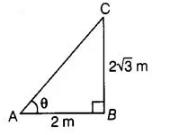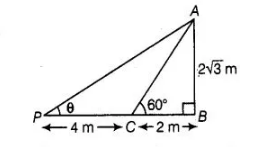If the length of the shadow of a tower is increasing, then the angle of elevation of the Sun is also increasing.
False
To understand the fact of this question, consider the following example I. A tower $2 \sqrt{3} \mathrm{~m}$ high casts a shadow $2 \mathrm{~m}$ long on the ground, then the Sun's elevation is $60^{\circ}$.

In $\triangle A C B$, $\tan \theta=\frac{A B}{B C}=\frac{2 \sqrt{3}}{2}$
$\Rightarrow \quad \tan \theta=\sqrt{3}=\tan 60^{\circ}$
$\therefore \quad \theta=60^{\circ}$
II. A same hight of tower casts a shadow $4 \mathrm{~m}$ more from preceding point, then the Sun's elevation is $30^{\circ}$.

In $\Delta A P B, \quad \tan \theta=\frac{A B}{P B}=\frac{A B}{P C+C B}$
$\Rightarrow$ $\tan \theta=\frac{2 \sqrt{3}}{4+2}=\frac{2 \sqrt{3}}{6}$
$\Rightarrow$ $\tan \theta=\frac{\sqrt{3}}{3} \cdot \frac{\sqrt{3}}{\sqrt{3}}=\frac{3}{3 \sqrt{3}}$
$\Rightarrow$ $\tan \theta=\frac{1}{\sqrt{3}}=\tan 30^{\circ}$
$\therefore \quad \theta=30$
Hence, we conclude from above two examples that if the length of the shadow of a tower is increasing, then the angle of elevation of the Sun is
decreasing.
Alternate Method
False, we know that, if the elevation moves towards the tower, it increases and if its elevation moves away the tower, it decreases. Hence, if the
shadow of a tower is increasing, then the angle of elevation of a Sun is not increasing
Click here to get exam-ready with eSaral
For making your preparation journey smoother of JEE, NEET and Class 8 to 10, grab our app now.
